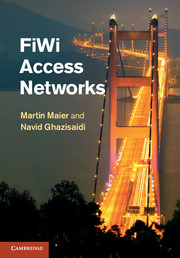Book contents
- Frontmatter
- Contents
- List of figures
- List of tables
- Preface
- Acknowledgments
- Part I Introduction
- Part II Fiber access networks
- Part III Wireless access networks
- Part IV FiWi access networks
- 10 RoF vs. R&F networks
- 11 Architectures
- 12 Network planning and reconfiguration
- 13 Techno-economic analysis
- 14 Network coding
- 15 Optical and wireless protection
- 16 Hierarchical frame aggregation
- 17 Routing and QoS continuity
- 18 Smart grid communications
- References
- Index
18 - Smart grid communications
from Part IV - FiWi access networks
Published online by Cambridge University Press: 05 January 2012
- Frontmatter
- Contents
- List of figures
- List of tables
- Preface
- Acknowledgments
- Part I Introduction
- Part II Fiber access networks
- Part III Wireless access networks
- Part IV FiWi access networks
- 10 RoF vs. R&F networks
- 11 Architectures
- 12 Network planning and reconfiguration
- 13 Techno-economic analysis
- 14 Network coding
- 15 Optical and wireless protection
- 16 Hierarchical frame aggregation
- 17 Routing and QoS continuity
- 18 Smart grid communications
- References
- Index
Summary
The world has become heavily dependent on oil through the widespread use of combustion engines in gasoline cars, resulting in climate change, massive transfers of wealth to oil-producing countries, and heightened geopolitical tensions. The advent of commercially available electric vehicles (EVs) by the end of 2010 is expected to be a game changer that will shake things up in a fundamental manner. Not only can electricity be produced in a number of environmentally friendly ways, e.g., hydroelectric generators, wind farms, or solar arrays, but also the electric engine is significantly more efficient than the combustion engine of traditional gasoline cars or today's gasoline–electric hybrids (Davis [2010]). A promising example of using EVs for a sustainable electric mobility (e-mobility) in urban areas is the “e-mobility Berlin” project, which deploys only green electricity from renewable sources to realize a user-friendly public charging infrastructure for plug-in EVs (PEVs). The emission-free PEVs may be shared following DAIMLER's “car-to-go” idea and allow environmental zones to be set up in cities, from which environmentally friendly PEVs with no emissions are exempt (DAIMLER [2009]). Replacing gasoline vehicles with PEVs could reduce the importation of oil by up to 52% in the United States. Despite their huge potential to create new markets, revenues, and jobs, PEVs pose severe challenges to electric utility companies. A PEV being charged at home in the evening may more than double the average household electricity load and thereby dramatically exacerbates the load profile imbalance of power grids between off- and on-peak hours (Ipakchi and Albuyeh [2009]).
- Type
- Chapter
- Information
- FiWi Access Networks , pp. 207 - 217Publisher: Cambridge University PressPrint publication year: 2011



